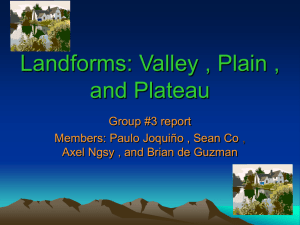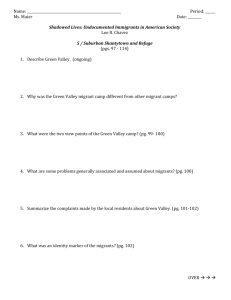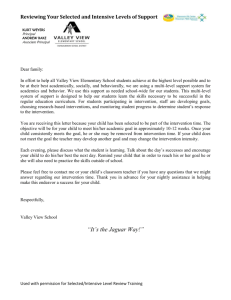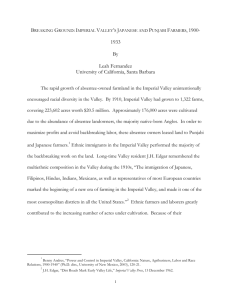press release - American Public Television
advertisement
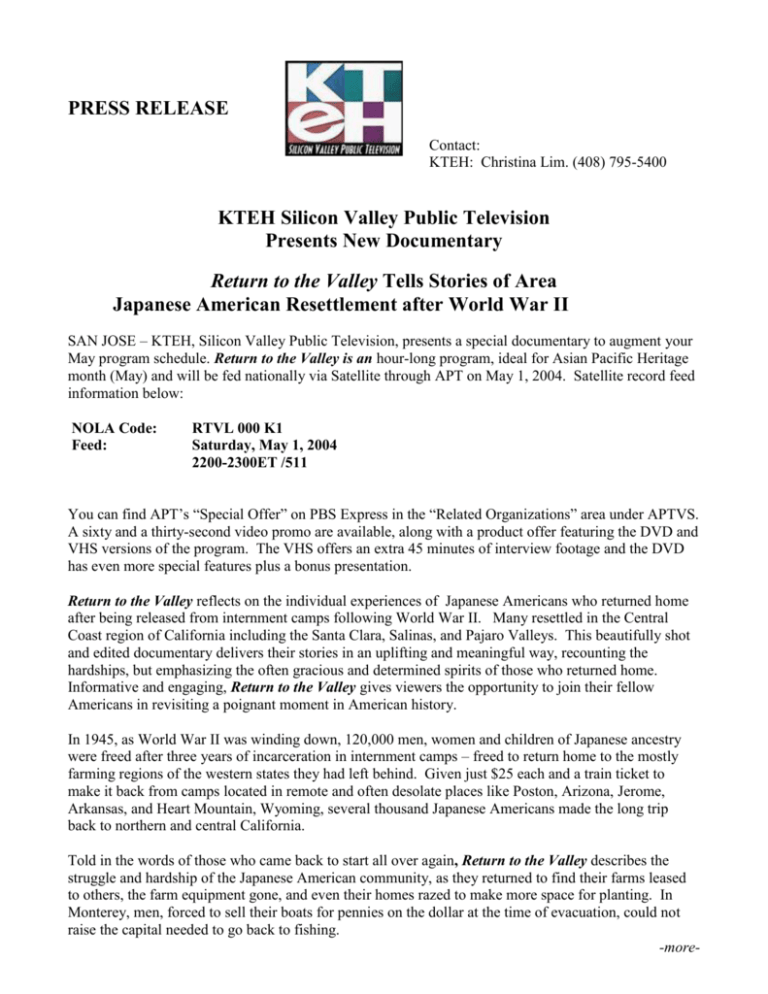
PRESS RELEASE Contact: KTEH: Christina Lim. (408) 795-5400 KTEH Silicon Valley Public Television Presents New Documentary Return to the Valley Tells Stories of Area Japanese American Resettlement after World War II SAN JOSE – KTEH, Silicon Valley Public Television, presents a special documentary to augment your May program schedule. Return to the Valley is an hour-long program, ideal for Asian Pacific Heritage month (May) and will be fed nationally via Satellite through APT on May 1, 2004. Satellite record feed information below: NOLA Code: Feed: RTVL 000 K1 Saturday, May 1, 2004 2200-2300ET /511 You can find APT’s “Special Offer” on PBS Express in the “Related Organizations” area under APTVS. A sixty and a thirty-second video promo are available, along with a product offer featuring the DVD and VHS versions of the program. The VHS offers an extra 45 minutes of interview footage and the DVD has even more special features plus a bonus presentation. Return to the Valley reflects on the individual experiences of Japanese Americans who returned home after being released from internment camps following World War II. Many resettled in the Central Coast region of California including the Santa Clara, Salinas, and Pajaro Valleys. This beautifully shot and edited documentary delivers their stories in an uplifting and meaningful way, recounting the hardships, but emphasizing the often gracious and determined spirits of those who returned home. Informative and engaging, Return to the Valley gives viewers the opportunity to join their fellow Americans in revisiting a poignant moment in American history. In 1945, as World War II was winding down, 120,000 men, women and children of Japanese ancestry were freed after three years of incarceration in internment camps – freed to return home to the mostly farming regions of the western states they had left behind. Given just $25 each and a train ticket to make it back from camps located in remote and often desolate places like Poston, Arizona, Jerome, Arkansas, and Heart Mountain, Wyoming, several thousand Japanese Americans made the long trip back to northern and central California. Told in the words of those who came back to start all over again, Return to the Valley describes the struggle and hardship of the Japanese American community, as they returned to find their farms leased to others, the farm equipment gone, and even their homes razed to make more space for planting. In Monterey, men, forced to sell their boats for pennies on the dollar at the time of evacuation, could not raise the capital needed to go back to fishing. -more- Press Release: Return to the Valley, page 2 Japanese Americans, now senior citizens, tell of unimaginable hard work, discrimination, and the continuing fight for civil rights and civil liberties as they farmed strawberries, cut flowers, and found new occupations. Featured interviews include Issei (first generation immigrants) Phillip Kobashi, a 99 year old retired strawberry farmer; Suenyo Inada, at 101, possibly the last of the pioneer brides; and Nisei (second generation, born in America) Dave Tatsuno, longtime owner of the San Jose’s Nichi Bei Busan store; farmers Eichii Edward Sakauye, John Hayakawa, and Mits Koshiyama. Chizu Kubo, Helen Nitta Mitto and Kay Izumazaki, talk about changes in the family structure and role of women. Ken Kashiwahara, an award-winning journalist and former ABC News reporter and San Francisco bureau chief, is the narrator of Return to the Valley. The Japanese American community has been so supportive during the almost two years we’ve been working on Return to the Valley,” explains Christina Lim, KTEH producer. “The Nisei seniors really want this story told and told now.” Using a combination of archival and personal photographs, rare home movies, and newsreel film, KTEH has brought the stories of the Japanese American community to life. The viewing audience will have glimpses of the Santa Clara Valley and Watsonville in the 1920’s, and San Jose’s Japantown in the 1950’s. Also included is home movie footage from the Manaka family of Monterey. Frank and Royal Manaka were the only Japanese Americans to return to large-scale fishing after the war. Return to the Valley is a poignant look at what it was like to live in the Santa Clara, Salinas, Santa Cruz-Watsonville, and Monterey area as a Japanese American, as well as a look at this region before high tech and shopping malls. Return to the Valley, has been funded by the California Civil Liberties Public Education Program, Community Foundation of Silicon Valley donor advised accounts, and the Henri and Tomoye Takahashi Charitable Foundation. The on-line teacher’s guide, available to educators and students for absolutely no-cost can be viewed at www.returntothevalley.org. Teacher guide and DVD programming has been funded by HewlettPackard Company, and Lockheed Martin. ABOUT APT: For 42 years, American Public Television (APT) has been a prime source of programming for the nation's public television stations. APT has more than 10,000 hours of available programming including Discovering the Real World of Harry Potter, Globe Trekker, Muhammad Ali: Through the Eyes of theWorld, Nightly Business Report, Rick Steves' Europe, Julia and Jacques Cooking at Home, Ballykissangel, Brian Jacques' Redwall and Sinatra: The Classic Duets. APT is known for identifying innovative programs and developing creative distribution techniques for producers. In more than four decades,it has established a tradition of providing public television stations nationwide with program choices that enable them to strengthen and customize their schedules. Press should contact Donna Hardwick at 617-338-4455 ext. 129 or via email to donna_hardwick@aptonline.org. For more information aboutAPT's programs and services, log on to aptonline.org. ######



